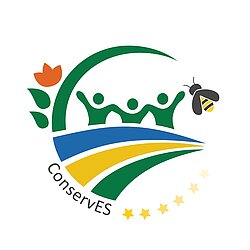ConservES
ConservES - Living-lab approach to floral enrichment as a tool to conserve biodiversity and maximising ecosystem services in European agricultural landscapes

Sarah Redlich
Funder: BioDivERSA/Bundesministerium für Bildung und Forschung
Start time: 01/03/2023
End time: 28/02/2026
Introduction:
Modern agriculture in Europe is the driving force behind the simplification of ecological networks and the loss of biodiversity in agricultural landscapes. ConservES aims to maintain biodiversity in intensive agro-ecosystems through flora enrichment (combined flower strips and hedgerows) and to promote associated ecosystem services, i.e. natural processes such as pest and weed control or pollination. For this purpose, ConservES uses Europe-wide climate and landscape gradients to gain better insights into potential interactions with the environment. Floral enrichment is planned and implemented using an innovative living lab approach, a cooperation with stakeholders from the academic, business, public, and civil society sectors. This promotes regional, effective and long-term solutions for the conservation of biodiversity and provided ecosystem services in agroecosystems. Within the project, the university of Würzburg is investigating the impact on biodiversity in German agricultural landscapes and the influence on production-relevant ecosystem services.
Would you like to know more about the project or be involved in the Living Lab? Then get in touch:
Dr. Sarah Redlich (Projektleitung)
Tel: 0931/31-82129
Dr. Ute Fricke (Projektmitarbeiterin)
Tel: 0931/31-88120
E-Mail: conserves@uni-wuerzburg.de
A sneak peek at the world's first "BioBlitz" in agricultural landscapes: Discovering biodiversity in the field!
In June, interested citizens had the opportunity to be researchers themselves for a day and discover the diversity of the animal and plant world at the BioBlitz as part of the ConservES project in Würzburg. At four different stations, participants were able to become active in the field themselves and work with experts to find and identify animals and plants in and around agricultural fields.
What is a BioBlitz?
It is an (area-wide) inventory of biological diversity within a short period of time (here 24 hours). Interested citizens and researchers participate in sampling, sorting and recording the data. The BioBlitz offers the possibility of a broad exchange between all participants, promotes the formation of opinions and gives impulses for the implementation of new practices.
How does the BioBlitz work?
A farmer invites interested citizens to join scientists in exploring and measuring biodiversity in his or her fields, field margins and adjacent habitat.
ConservES BioBlitz - 17/18 June 2023
Take part in the world's first BioBlitz in agricultural landscapes!
What is a BioBlitz?
A BioBlitz is an inventory of biodiversity within a short period of time. Interested citizens, farmers and scientists take part in the sampling, sorting and digitalisation of the data. In the process, participants not only discover the diversity of nature and learn about the role of animals and plants in it, but also gain insights into the work of biologists.
When? 17 June 2023, 12 am to 18 June 2023, 12 am (24 h)
Where? Fields, meadows, orchards and hedgerows behind the Biozentrum of the University of Würzburg
Who can participate? Farmers, citizens or naturalists of all ages
No knowledge of species or previous experience is required. The interest and desire to learn more about nature on your doorstep are sufficient!
Interested? Then you can register here (no matter which activity you finally decide on): Link to registration website or via email to conserves@uni-wuerzburg.de
Programme
Depending on your mood, you have the choice between different activities:
- Flexible, self-guided exploration tour through the agricultural habitats (only partly suitable for wheelchairs/pushchairs): Discover alone, with (grand)children or friends the habitats field, orchard, flower strip and hedge, equipped with an explorer's kit, which you will receive at registration. At various stations along the way, you can learn more about the animal and plant world, look over the shoulders of experts at work and try out various scientific methods for yourself.
For children we offer activities for which stamps can be collected and a small surprise picked up at the end of the day at the base camp. - Flexible, self-guided tour of the campus (suitable for wheelchairs/pushchairs): follow the biodiversity trail of the Living Campus Initiative and learn about different habitats on campus: orchard, hedge, pond and flowering meadow. Along the way you will see various small biotopes, which can also provide a habitat for animals in your garden (dead wood, rock piles, flowering areas, etc).
For each habitat there are information signs and activity boards for children that invite you to discover the different habitats. - Guided activities by experts: experts for various animal and plant groups invite you to learn more about scientific methods used for recording organisms, their diversity and their role in nature. Activities take place at any time of the day or night. Registration recommended (limited number of participants!)
Please register for guided activities using the registration form or per email conserves@uni-wuerzburg.de - Visit the interactive exhibition "Biodiversity in Agricultural Landscapes" in the Biozentrum Foyer: learn more about biodiversity in agricultural landscapes, our "special species" (Montagu's Harrier, Field Hamster) and how to protect them. The perfect conclusion after a day full of discoveries!
Meeting point:
Start of your exploration and meeting point for guided activities is the base camp in the Biozentrum Foyer (basement).
Lageplan BioBlitz (49.780607032343816, 9.971147227006448)
How to get there:
The Biozentrum can be easily reached by bus (e.g. line 10), bicycle or on foot (e.g. from the districts Gerbrunn, Frauenland, Am Hubland). Parking is available in front of the Biozentrum and along the Theodor Boveri Weg.



![[Translate to Englisch:] BioBlitz1](/fileadmin/_processed_/a/d/csm_BioBlitz_Programm_2023_1_f20e1ac64a.jpg)
![[Translate to Englisch:] BioBlitz2](/fileadmin/_processed_/8/d/csm_BioBlitz_Programm_2023_2_18e2f3600c.jpg)
![Flower strips are the focus of a Europe-wide research project involving scientists from the University of Würzburg. (Image: Didgeman / Pixabay) [Translate to Englisch:] pixabay](/fileadmin/_processed_/5/d/csm_Pixaby_Thomas_d49af095aa.jpg)





